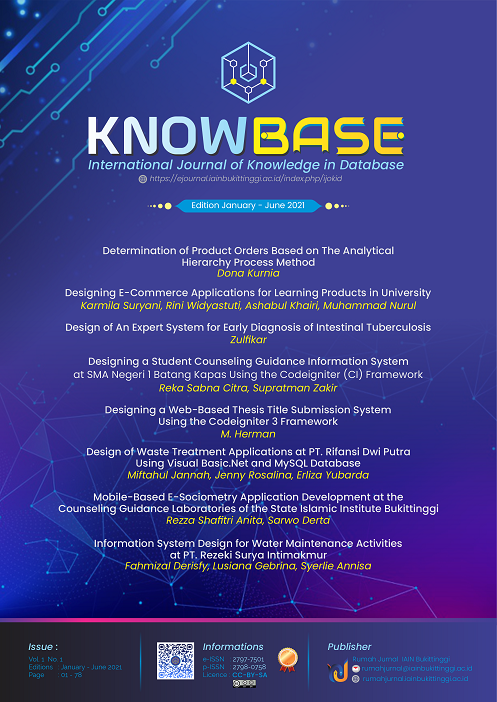Designing E-Commerce Applications for Learning Products in University
DOI:
https://doi.org/10.30983/ijokid.v1i1.5032Keywords:
e-commerce, waterfall model, marketingAbstract
E-commerce applications to sell various products produced by students in higher education can increase income-generating. However, a few universities still use e-commerce to sell student products, especially learning products. This research aims to produce an e-commerce application for web-based learning products in universities. The research method is development research with a research design using the waterfall model. The waterfall model procedure consists of analysis, design, coding, and testing. The system design uses Unified Modeling Language (UML) modeling such as context diagrams, class diagrams, use case diagrams, and activity diagrams. The system's coding uses the PHP programming language, Jquery, and the Boostrap Framework. The testing stage is through black-box analysis carried out by experts in the field of system design, with the results of testing each case being well-integrated and feasible to be applied. The result of the research is a web-based e-commerce application that sells learning products in universities.
References
F. Mulia and B. M. Sulungbudi, “Pemanfaatan Teknologi Digital Pada UMKM (Studi Penggunaan Internet Pada PPKM Kabupaten Bandung),†vol. 4, no. 2, pp. 1–11, 2020.
A. Burcori, “Pentingnya Literasi Digital Untuk Meningkatkan Partisipasi Masyarakat Dalam Sosialisasi Pembangunan Melalui Media Sosial,†OMNICOM J. Ilmu Komun., vol. 4, no. 1, pp. 1–6, 2018.
Y. Irma and L. Suryani, “Perancangan E-Commerce Batik Pada Batik Banten,†J. Ilm. Sains Teknol., vol. 1, no. 2, pp. 66–81, 2018.
J. Geelhaar and G. Rausch, “3D Web Applications in E-Commerce - A secondary study on the impact of 3D product presentations created with HTML5 and WebGL,†2015 IEEE/ACIS 14th Int. Conf. Comput. Inf. Sci. ICIS 2015 - Proc., pp. 379–382, 2015.
H. Zheng, “A study on the usability of E-commerce websites between China and Thailand,†Int. J. Simul. Syst. Sci. Technol., vol. 17, no. 1, pp. 34.1-34.4, 2016.
S. K. Panda, S. K. Swain, and R. Mall, “An Investigation into Usability Aspects of E-Commerce Websites Using Users ’ Preferences,†Adv. Comput. Sci. an Int. J., vol. 4, no. 1, pp. 65–73, 2015.
M. C. Anchahua, L. V. Garnique, and J. A. Tarazona, “User Experience Maturity Model for Ecommerce Websites,†2018 Congr. Int. Innov. y Tendencias en Ing. CONIITI 2018 - Proc., pp. 1–6, 2018.
S. D. Axinte and I. C. Bacivarov, “Improving the Quality of Web Applications Through Targeted Usability Enhancements,†Proc. 10th Int. Conf. Electron. Comput. Artif. Intell. ECAI 2018, pp. 1–4, 2019.
F. Kawaf and D. Istanbulluoglu, “Online fashion shopping paradox: The role of customer reviews and facebook marketing,†J. Retail. Consum. Serv., vol. 48, pp. 144–153, 2019.
S. Sohn, “A contextual perspective on consumers’ perceived usefulness: The case of mobile online shopping,†J. Retail. Consum. Serv., vol. 38, no. January, pp. 22–33, 2017.
J. Kim, M. Kim, J. Choi, and M. Trivedi, “Offline social interactions and online shopping demand: Does the degree of social interactions matter?,†J. Bus. Res., vol. 99, no. September, pp. 373–381, 2019.
A. Ibrahim, S. D. R. Napian, A. Firanisa, Sartika, R. D. Sari, and M. Audya, “The Effect of E-Commerce Application Service Quality of Customer Loyalty Using Customer Relationship Management Approach,†vol. 172, no. Siconian 2019, pp. 680–687, 2020.
T. H. Liao, “Online shopping post-payment dissonance: Dissonance reduction strategy using online consumer social experiences,†Int. J. Inf. Manage., vol. 37, no. 6, pp. 520–538, 2017.
Sugiyono, Metode Penelitian Kuantitatif, Kualitatif, dan R&D. Bandung, 2018.
S. A. S., Rosa, M. Rekayasa Perangkat Lunak Terstruktur Dan Berorientasi Objek, vol. 1. Bandung: Informatika, 2018.
R. Belwal and M. Amireh, “Service quality and attitudinal loyalty: Consumers’ perception of two major telecommunication companies in Oman,†Arab Econ. Bus. J., vol. 13, no. 2, pp. 197–208, 2018.
S. Kanimozhi, Selvasarathi, Shanmathi, Sneha, “Recommendation System Using Hybrid Classification Algorithm in E-Commerce Application,†Turkish J. Physiother. …, vol. V, no. 2, pp. 2305–2311.
F. F. Cheng, C. S. Wu, and Y. C. Chen, “Creating customer loyalty in online brand communities,†Comput. Human Behav., vol. 107, no. 181, p. 105752, 2020.
V. Oktaviani, B. Warsito, H. Yasin, R. Santoso, and Suparti, “Sentiment analysis of e-commerce application in Traveloka data review on Google Play site using Naïve Bayes classifier and association method,†J. Phys. Conf. Ser., vol. 1943, no. 1, pp. 1–9, 2021.
J. J Sivasankar, E., & Vijaya, “A study of feature selection techniques for predicting customer retention in telecommunication sector,†Int. J. Bus. Inf. Syst., vol. 31, pp. 1–26, 2019.
T. Wu, X. Liu, J. Qin, and F. Herrera, “An interval type-2 fuzzy Kano-prospect-TOPSIS based QFD model: Application to Chinese e-commerce service design,†Appl. Soft Comput., vol. 111, p. 107665, 2021.
Downloads
Published
How to Cite
Issue
Section
Citation Check
License
Authors who publish with this journal agree to the following terms:
- Authors retain copyright and grant the journal right of first publication with the work simultaneously licensed under a Creative Commons Attribution License that allows others to share the work with an acknowledgment of the work's authorship and initial publication in this journal.
- Authors are able to enter into separate, additional contractual arrangements for the non-exclusive distribution of the journal's published version of the work (e.g., post it to an institutional repository or publish it in a book), with an acknowledgment of its initial publication in this journal.
- Authors are permitted and encouraged to post their work online (e.g., in institutional repositories or on their website) prior to and during the submission process, as it can lead to productive exchanges, as well as earlier and greater citation of published work (See The Effect of Open Access).



